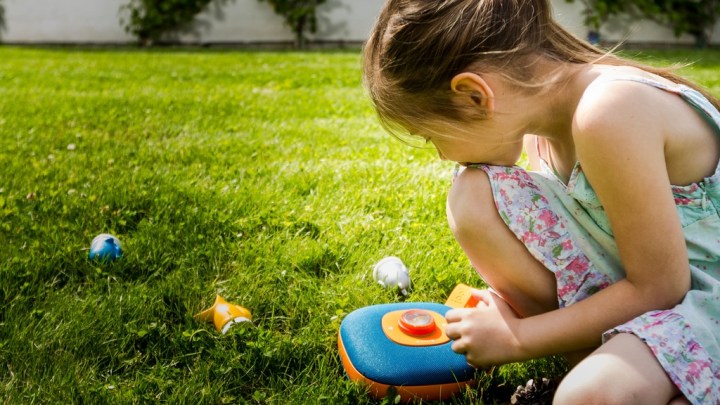
Jooki’s concept will be immediately familiar to anyone who’s used an Amiibo. It’s a bright and bulbous blue-and-orange jukebox that looks sort of like an oversized lunchbox, and it ships with one plastic figurine and five flat, circular tokens — “stars” — with suction cups affixed to their posteriors. In its center sits an illuminated button, and placing the aforementioned figures — a blue whale, yellow fox, silver knight, or green dragon — atop it triggers the playback of a predefined song. Doing the same with a token, meanwhile, starts a playlist of ‘tunes, audio clips, albums, or radio stations.

The idea was to make it easy for kids to play their favorite song without having to fiddle around with, say, a smartphone. To that end, Jooki replaces a digital display with the figurines, sports simple controls — a stop/pause button, fast forward, rewind, and volume adjustment — and, arguably most importantly, features an optional smartphone app that lets parents manage almost every facet of the listening experience. They can associate new songs, audiobooks, or albums with each figure, and control music playback. And if the kids are bound for someplace without readily available Wi-Fi, they can transfer local music from an iTunes account to the Jooki’s internal storage.
Thanks to wireless connectivity, the Jooki can act essentially as an external speaker, too. It’ll be compatible with music services like Spotify or Google Play Music, too, and it supports most radio services including streaming platforms like Soundcloud.”

Jooki’s the brainchild of Muuselabs co-founder Theo Marescaux, former product manager for digital cinema company Barco. His kids served as the primary inspiration for the toy. “My three-year-old daughter wanted me to play a specific song — Queen’s We Will Rock You — but because we don’t use CDs anymore, I had to go into my phone, look for the song, play it,” he told Digital Trends. “And even more frustratingly, I had to do it all again when she came back five minutes later and asked to hear it a second time.”
With the help of Will Moffat, a former Google employee, and Pieter Palmers, a Huawei engineer, Marescaux hacked together a prototype jukebox that relied on QR codes and webcams. A few years later, after bootstrapping the project with their own financing and receiving a grant from the European Union-backed European Pioneers, the team launched Jooki on Kickstarter.

Why Kickstarter? “We want to first focus on Kickstarter, understanding the feedback from the community, making any tweaks as plans to launch,” he explained. Their first priority: making sure Jooki delivers high-quality audio. “We don’t want it to sound like a toy. We’re focusing on summarizing what we have learned from the community and making sure we deliver a solid product with a solid first experience.”
As for the future, Marescaux believes that Jooki’s real growth potential is in its internet connectivity. “Because it’s connected, you can do simple gaming or leave messages,” he said — parents can leave friendly reminders for their kids, or daily digests in the form of voicemails, for example. “But the ideas for development are huge — we want to focus on delivering the core value of the product.” Marescaux sees especially big potential in a much older demographic, like elderly parents who aren’t as technologically savvy as their grandchildren.
Jooki’s retailing at the early bird price of 89 euros, or about $100. Once the initial Jooki’s ship to Kickstarter backers in June of next year, the team’s planning launches in hi-fi gadget stores and mainstream retail in the second half of 2017.
But its the early days, Marescaux said. “There’s a whole range of ideas that we have,” he said.
